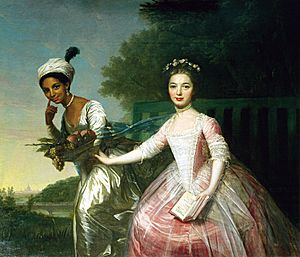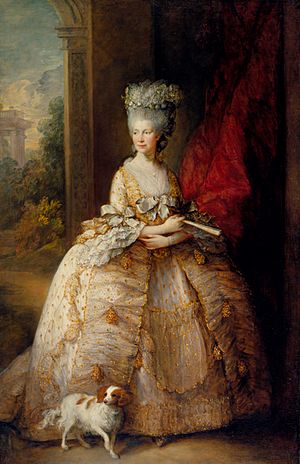Lady Elizabeth Finch-Hatton facts for kids
Quick facts for kids
Lady Elizabeth Murray
|
|
|---|---|

Murray (right) and her cousin Dido Elizabeth Belle
|
|
| Born |
Elizabeth Mary Murray
18 May 1760 |
| Died | 1 June 1825 (aged 65) |
| Nationality | British |
| Spouse(s) | |
| Children |
|
| Parent(s) |
|
| Relatives |
|
Lady Elizabeth Mary Finch-Hatton (born Lady Elizabeth Mary Murray; 18 May 1760 – 1 June 1825) was an important British lady from a noble family. She is famous for being in a well-known painting. This painting was once thought to be by Johann Zoffany, but now people believe it was painted by David Martin.
Contents
Lady Elizabeth's Early Life
Elizabeth Murray was born on May 18, 1760, in Warsaw, which was then part of Poland-Lithuania. Her father was David Murray, 2nd Earl of Mansfield. Her mother was Countess Henrietta Frederika von Bünau from Germany. Her grandfather was Count Heinrich von Bünau.
Her father, who was then called Viscount Stormont, met her mother in Dresden. He was working there as an ambassador, representing Britain. They fell in love and got married on August 16, 1759, in Warsaw. Even though her mother was very rich, it was unusual for a politician to marry a foreign noblewoman. Their marriage was based purely on love.
When her father was an ambassador in Vienna, his wife, Countess Henrietta, played a big role. She was a German noblewoman, so she could host her own salons. These were social gatherings where important people met to talk. Her father, Count von Bünau, was well-known in Vienna. This helped Henrietta fit into the high society there.
Countess Henrietta was very charming. She even impressed Prince Kaunitz, a powerful advisor to Empress Maria Theresa. Her charm helped her husband become part of the royal family's private circle. This made Viscount Stormont's time as ambassador in Vienna very successful.
Elizabeth had a younger sister named Henrietta, who was born in Dresden. Sadly, Henrietta died young in Vienna. Their mother, Countess Henrietta, also died young on March 16, 1766, at just 29 years old. She was buried in Vienna, but her heart was placed in a golden vase. This vase traveled with her husband everywhere and was later taken to his family home, Scone Palace.
After her mother's death in 1766, her father was very sad and took a break from work. He was a single parent and his job as an ambassador meant he couldn't give Elizabeth a stable home. So, he arranged for Elizabeth to live in England. She was raised by his uncle, William Murray, 1st Earl of Mansfield, and his wife at Kenwood House. Her father's unmarried sister, Lady Anne, also helped raise her. Later, Lord Mansfield also took in his great-niece, Dido Belle, who came from the West Indies.
Life at Kenwood House

Lady Elizabeth Murray was six years old when she moved to Kenwood House in Hampstead. She was raised by her great-uncle, William Murray, 1st Earl of Mansfield. Her father, Viscount Stormont, was set to inherit his uncle's title and all his wealth, including Kenwood House.
It is known that Dido Belle helped manage the dairy and poultry areas. This was a common task for women of noble families. However, it is not clear if Lady Elizabeth also helped with these tasks.
In 1766, Lady Anne Murray, one of Viscount Stormont's unmarried sisters, came to live at Kenwood. She was Elizabeth's aunt. Lady Anne, Elizabeth, and Dido lived there together. Later, another aunt, Lady Marjory, also joined them before Lady Mansfield passed away.
Lady Elizabeth received an allowance of £100 each year from her great-uncle. Dido received £20 yearly. This difference might have been because of Dido's race and that she was born outside of marriage. Lady Elizabeth likely received more because her father was Lord Mansfield's heir.
Dido Belle and Lady Elizabeth were very close during their time at Kenwood. An American visitor named Thomas Hutchinson noticed their strong bond in 1779. This was around the time their famous portrait was painted by David Martin.
Lord Mansfield really loved Lady Elizabeth. He would often take her riding to visit neighbors. In 1778, a lady named Boscawen wrote that she felt very honored when Lord Mansfield and Miss Eliza Murray visited her. After their visit, Lord Mansfield and "his fair niece" rode back to Kenwood. A heavy rain shower started, but Miss Elizabeth Murray later wrote that they managed to avoid the rain.
Ten years after her mother's death, her father, Viscount Stormont, married again. He married Louisa Cathcart on May 6, 1776. Lady Elizabeth's father often visited her. She also regularly visited her father and stepmother at their homes. Letters show that she wrote to a friend about the birth of her stepmother's third son. Elizabeth also called her stepmother "our dear Lady Stormont," which shows they had a good relationship.
Her father wanted to take Lady Elizabeth to Paris, where he was an ambassador. However, "Lady Mansfield wouldn't let her go with us, which I regret greatly." In March 1778, France declared support for the American Revolution against Britain. Ambassadors from both countries were quickly called back home. Lord Stormont returned to England at the end of March, just in time for Elizabeth's 18th birthday in May.
Royal Balls and Social Life

In the spring of 1784, The Prince of Wales asked for Mary Hamilton to be invited to a Royal ball. Lady Stormont, Elizabeth's stepmother, was also invited. On the day of the ball, March 10, Hamilton wrote in her diary that Lady Stormont had invited her stepdaughter, Lady Elizabeth, to the Prince's royal ball at Carlton House. Elizabeth was there when Lady Stormont picked up Hamilton in her carriage. They arrived at the ball together and were greeted by the Prince. Although Lady Elizabeth was invited, Dido Belle was not invited to the royal ball.
Elizabeth's father, Lord Stormont, was an important noble. He often invited Elizabeth to court events and royal balls.
On February 16, 1781, Mary Hamilton described a Royal Ball held at Queen's House. Lady Elizabeth was noted as one of the ladies who danced. Her father and stepmother were also there. The ball started with country dances, and partners changed after every two dances. Queen Charlotte stayed in the Ballroom all evening. The Prince of Wales danced with many ladies. The ball ended at half past five in the morning. Hamilton also noted that all the ladies, including Elizabeth, wore Sack-back gowns.
On August 12, 1781, Lady Elizabeth attended another Royal ball at Windsor Castle. She went with her father, Lord Stormont. Her stepmother, Lady Stormont, was not there because she was pregnant. This ball celebrated the Prince of Wales's birthday. Lady Elizabeth was among the young ladies who danced at the ball.
Lady Elizabeth was also invited to her stepmother Lady Stormont's ball in January 1782. It was at her stepmother's house. This is where she met her future husband, George Finch Hatton. He was among the guests.
Sadly, her cousin and friend, Dido Belle, was not invited to any of these balls. This was partly because she was born outside of marriage. In Mary Hamilton's diary, Dido Belle was never mentioned, even though Hamilton visited Kenwood many times and described other family members.
After Lady Mansfield's death in 1784, Lady Elizabeth's two aunts, Anne and Marjory, took charge of the household. They also helped their uncle by writing down what he dictated. Lady Charlotte Wentworth noted that Anne and Marjory loved and cared for their uncle like a father.
Lady Elizabeth became engaged on November 5, 1785. A friend wrote that the Hatton family was lucky to receive such a "treasure" into their family.
Marriage and Family Life

On December 15, 1785, Lady Elizabeth Mary Murray, at 25 years old, married George Finch-Hatton. Their marriage was based on love. They were married at Lord Mansfield's house in London. George was from the noble Finch family and was Lady Mansfield's nephew. He had inherited Eastwell Park in 1769 and Kirby Hall in 1771.
After the wedding, the couple went to Kenwood for celebrations. Then, Lady Elizabeth left Kenwood and began her married life at her husband's two large estates, Kirby Hall and Eastwell Park. Lady Elizabeth's dowry, which was money or property she brought into the marriage, was about £17,000. She would also inherit £22,000 from her aunts later. Her total inheritance was around £40,000.
George and Lady Elizabeth had seven children:
- Louisa Anne (died March 1, 1875)
- Anna Maria (died December 2, 1838)
- Elizabeth Henrietta (died 1820)
- George Finch-Hatton, 10th Earl of Winchilsea (born May 19, 1791 – died January 8, 1858)
- Edward Frederick, a Lieutenant, who died at age 20.
- Rev. Daniel Heneage Finch-Hatton (born 1795 – died January 1866)
- Emily Finch-Hatton (born 1797)
They rebuilt Eastwell Park between 1793 and 1799. George told his architect, Joseph Bonomi, to make sure his wife, Lady Elizabeth, had a large dressing room. This plan was followed. The new house was very grand, with a beautiful front and splendid rooms.
Lady Elizabeth seemed to have a close relationship with her half-brother, the 3rd Earl of Mansfield. He sometimes studied at Kenwood. He named his second daughter after Elizabeth and their aunt Lady Anne. He also let Lady Elizabeth host balls at Mansfield House, a very fancy townhouse in London. Their father had bought this house for a lot of money, and they both spent a lot of time there growing up.
Notable Descendants
Lady Elizabeth Murray was the great-grandmother of Denys Finch Hatton. He is known as a lover of the Danish author Karen Blixen, who wrote the book Out of Africa.
Denys's older brother was Guy Montagu George Finch-Hatton. He married Margaretta Armstrong Drexel, a rich heiress from a banking family. Their son married the third daughter of Gladys Vanderbilt Széchenyi.
Elizabeth is also an ancestor of the actress Anna Chancellor. Her other direct descendants still hold the title of Daniel Finch-Hatton, 17th Earl of Winchilsea. The current holder's son, Tobias Joshua Stormont Finch-Hatton, is the next in line for the title.
Death

Lady Elizabeth died in York Place, Edinburgh, on June 1, 1825. She was 65 years old.



